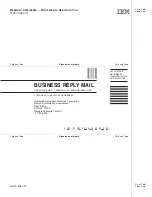
combination
of
characters
and
symbols
transmitted
from
one
point
to
another.
(4)
A
logical
partition
of
the
user
device’s
data
stream
to
and
from
the
adapter.
See
also
error
message
,
operator
message
.
MICR.
See
magnetic
ink
character
reader
and
magnetic
ink
character
recognition.
module.
A
program
unit
that
is
discrete
and
identifiable
with
respect
to
compiling,
combining
with
other
units,
and
load;
for
example,
the
input
to,
or
output
from,
an
assembler,
compiler,
linkage
editor,
or
executive
routine.
N
network.
(1)
A
configuration
of
data
processing
devices
and
software
connected
for
information
interchange.
(2)
An
arrangement
of
nodes
and
connecting
branches.
Connections
are
made
between
data
stations.
network
architecture.
The
logical
structure
and
operating
principles
of
a
computer
network.
Note:
The
operating
principles
of
a
network
include
those
of
services,
functions,
and
protocols.
nit.
A
nit
is
a
unit
of
luminance
equal
to
one
candela
per
square
meter.
It
is
often
used
to
quote
the
brightness
of
computer
displays.
noise.
(1)
A
disturbance
that
affects
a
signal
and
that
can
distort
the
information
carried
by
the
signal.
(2)
Random
variations
of
one
or
more
characteristics
of
any
entity,
such
as
voltage,
current,
or
data.
(3)
Loosely,
any
disturbance
tending
to
interfere
with
normal
operation
of
a
device
or
system.
nonvolatile
random
access
memory
(NVRAM)
.
Random
access
memory
that
retains
its
contents
after
electrical
power
is
shut
off.
Contrast
with
volatile
memory
.
NVRAM.
See
nonvolatile
random
access
memory.
O
operating
system.
Software
that
controls
the
execution
of
programs
and
that
may
provide
services
such
as
resource
allocation,
scheduling,
input/output
control,
and
data
management.
Although
operating
systems
are
predominantly
software,
partial
hardware
implementations
are
possible.
(T)
Operating
System/2
®
(OS/2
®
).
A
set
of
programs
that
control
the
operation
of
high-speed
large-memory
IBM
Personal
Computers
providing
multitasking.
Contrast
with
Disk
Operating
System
(DOS)
.
operator.
A
person
who
operates
a
machine.
operator
message.
A
message
from
the
operating
system
or
a
program
telling
the
operator
to
perform
a
specific
function
or
informing
the
operator
of
a
specific
condition
within
the
system,
such
as
an
error
condition.
option.
(1)
A
specification
in
a
statement,
a
selection
from
a
menu,
or
a
setting
of
a
switch,
that
can
be
used
to
influence
the
execution
of
a
program.
(2)
A
hardware
or
software
function
that
can
be
selected
or
enabled
as
part
of
a
configuration
process.
(3)
A
piece
of
hardware
(such
as
a
network
adapter)
that
can
be
installed
in
a
device
to
modify
or
enhance
device
function.
OS.
Operating
system.
OS/2.
Operating
System/2.
P
page.
The
information
displayed
at
the
same
time
on
the
screen
of
a
display
device.
panel.
(1)
A
thin
flat
sheet,
usually
(a)
of
pressed
metal
and
carrying
controls
and
indicators,
(b)
of
glass,
or
(c)
of
plastic.
(2)
A
formatted
display
of
information
that
appears
on
a
display
screen.
parallel
port.
A
port
that
transmits
the
bits
of
a
byte
in
parallel
along
the
lines
of
the
bus,
one
byte
at
a
time,
to
an
I/O
device.
On
a
personal
computer,
it
is
used
to
connect
a
device
that
uses
a
parallel
interface,
such
as
a
dot
matrix
printer,
to
the
computer.
Contrast
with
serial
port
.
PC.
See
personal
computer
.
personal
computer
(PC).
A
desk-top,
free-standing,
or
portable
microcomputer
that
usually
consists
of
a
system
unit,
a
display,
a
keyboard,
one
or
more
diskette
drives,
internal
fixed-disk
storage,
and
an
optional
printer.
PCs
are
designed
primarily
to
give
independent
computing
power
to
a
single
user
and
are
inexpensively
priced
for
purchase
by
individuals
or
small
businesses.
Examples
include
the
various
models
of
the
IBM
Personal
Computers.
plug.
(1)
A
connector
for
attaching
wires
from
a
device
to
a
cable,
such
as
a
store
loop.
A
plug
is
inserted
into
a
receptacle
or
plug.
(2)
To
insert
a
connector
into
a
receptacle
or
socket.
Plug
and
Play
(PnP).
Pertaining
to
the
capability
of
a
hardware
or
software
component
to
be
installed
on
a
system
with
minimal
effort
and
to
be
available
for
use
immediately
thereafter.
PnP.
See
Plug
and
Play
.
point-of-sale
(POS).
A
method
of
providing
information
to
support
sales
and
of
collecting
the
resulting
sales
information
from
retail
devices
located
in
stores.
Updated
October,
2008
Glossary
133
Summary of Contents for SurePOS 514
Page 2: ......
Page 8: ...Updated October 2008 vi SurePOS 500 Model 514 ...
Page 12: ...Updated October 2008 x SurePOS 500 Model 514 ...
Page 16: ...Updated October 2008 xiv SurePOS 500 Model 514 ...
Page 20: ...Figure 2 Serial number location Updated October 2008 4 SurePOS 500 Model 514 ...
Page 32: ...Installing the IBM SurePOS 500 Model 514 Updated October 2008 16 SurePOS 500 Model 514 ...
Page 64: ...Installing additional peripheral devices Updated October 2008 48 SurePOS 500 Model 514 ...
Page 68: ...Updated October 2008 52 SurePOS 500 Model 514 ...
Page 102: ...Updated October 2008 86 SurePOS 500 Model 514 ...
Page 138: ...Updated October 2008 122 SurePOS 500 Model 514 ...
Page 143: ...IBM IBM GA27 4004 GA27 4004 Updated October 2008 Appendix D Safety information 127 ...
Page 152: ...Updated October 2008 136 SurePOS 500 Model 514 ...
Page 156: ...Updated October 2008 140 SurePOS 500 Model 514 ...
Page 158: ...Updated October 2008 142 SurePOS 500 Model 514 ...
Page 161: ......














































